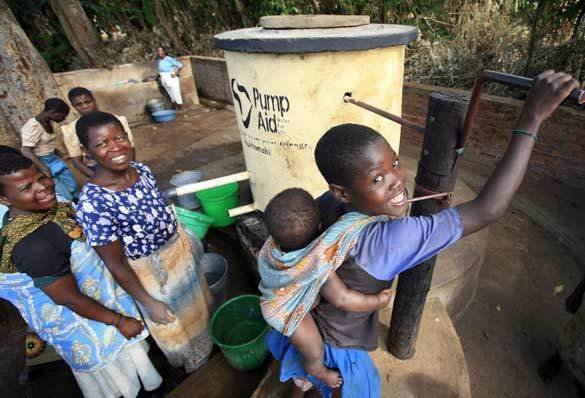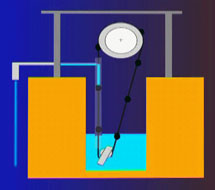Difference between revisions of "Elephant pump"
(→Construction, operation and maintenance) |
(→Manuals, videos and links) |
||
| Line 27: | Line 27: | ||
==Manuals, videos and links== | ==Manuals, videos and links== | ||
* [http://www.treehugger.com/clean-water/elephant-pump-wins-award.html Elephant Pump Wins Award]. July 2005. | * [http://www.treehugger.com/clean-water/elephant-pump-wins-award.html Elephant Pump Wins Award]. July 2005. | ||
| + | |||
{{#ev:vimeo|61981209|200|auto|<center><font size="2">Elephant Pump - <br>Pump Aid in Malawi</font></center>}} | {{#ev:vimeo|61981209|200|auto|<center><font size="2">Elephant Pump - <br>Pump Aid in Malawi</font></center>}} | ||
Revision as of 23:37, 6 September 2013

The Elephant Pump, designed by Pump Aid based on a 3,000-year-old Chinese design, is built from rope, a plastic pipe, some rubber washers, and a winding wheel. The name "Elephant Pump" refers to the device's strength, shape, and reliability. The pump can lift water from depths of 50 meters (160 ft), and can produce 1 litre (0.26 US gal) of water per second.
The Elephant Pump's design won the 1995 St Andrews Prize for the Environment for Pump Aid. The World Bank awarded a Development Marketplace grant in the amount of 120,000 United States dollars to Pump Aid in 2006, funding 1,000 pumps and enabling the development of the Elephant Toilet. The Elephant Pump has now provided over 1 million people in rural areas of Zimbabwe and Malawi with clean, safe water. Elephant Pumps can be maintained by poor rural communities without any assistance.
Pumps are built in response to grassroots demand and in full consultation with the local community. The local community come together to assist in the building process, providing materials such as bricks, sand, stones and unskilled labour. The Elephant Pump can also supply water for irrigating nutrition gardens where communities can grow crops to improve their diet and sell the surplus.
The pump is hand powered powered, but can be adapated to wind, solar or even a bicycle. 21 other African countries have lined up to implement similar projects.
Construction, operation and maintenance

To break the cycle of poverty in Africa, access to clean water for drinking and water for irrigation must be improved. Pump Aid builds appropriate technology water pumps, called Elephant Pumps that can be maintained by poor rural communities without any outside assistance. Using technology that has local currency, the well is built with local sand, stone and handmade bricks. The rope plugs, integral to the design, are made by melting and moulding local waste plastics.
build an Elephant pump

Costs
The cost of an Elephant Pump is a combination of two elements: ‘Hardware’ and ‘Installation’. The total cost of providing the hardware for the Elephant Pump is around £600, with small variances on items such as cement from country to country. The cost of installation can vary from country to country and region to region. It includes items such as survey cost, well digging, bricks, occasionally blasting and in country costs of staff and fuel etc. As a benchmark these have averaged in Malawi, for example, at £3000 per Elephant Pump installation.
According to Treehugger.com, a pump to serve 500 people can be made for a total cost of about £200 ($350 USD), with the major components having a lifespan of 50 years.
Manuals, videos and links
- Elephant Pump Wins Award. July 2005.
Pump Aid in Malawi
Acknowledgements
- Pump Aid. Wikipedia.
